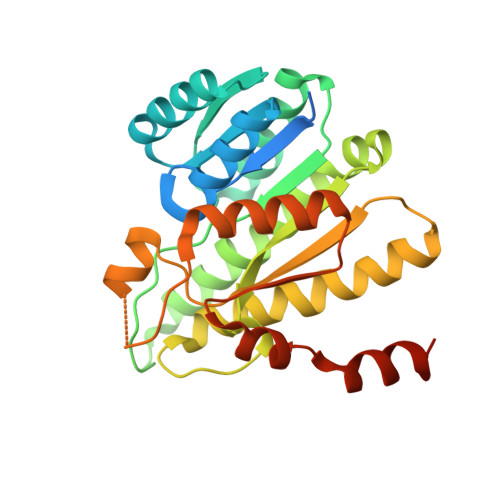Mechanistic Insight on the Mode of Action of Colletoic Acid.
Ling, T., Miller, D.J., Lang, W.H., Griffith, E., Rodriguez-Cortes, A., El Ayachi, I., Palacios, G., Min, J., Miranda-Carboni, G., Lee, R.E., Rivas, F.(2019) J Med Chem 62: 6925-6940
- PubMed: 31294974
- DOI: https://doi.org/10.1021/acs.jmedchem.9b00187
- Primary Citation of Related Structures:
6NJ7 - PubMed Abstract:
The natural product colletoic acid (CA) is a selective inhibitor of 11β-hydroxysteroid dehydrogenase type 1 (11β-HSD1), which primarily converts cortisone to the active glucocorticoid (GC) cortisol. Here, CA's mode of action and its potential as a chemical tool to study intracellular GC signaling in adipogenesis are disclosed. 11β-HSD1 biochemical studies of CA indicated that its functional groups at C-1, C-4, and C-9 were important for enzymatic activity; an X-ray crystal structure of 11β-HSD1 bound to CA at 2.6 Å resolution revealed the nature of those interactions, namely, a close-fitting and favorable interactions between the constrained CA spirocycle and the catalytic triad of 11β-HSD1. Structure-activity relationship studies culminated in the development of a superior CA analogue with improved target engagement. Furthermore, we demonstrate that CA selectively inhibits preadipocyte differentiation through 11β-HSD1 inhibition, suppressing other relevant key drivers of adipogenesis (i.e., PPARγ, PGC-1α), presumably by negatively modulating the glucocorticoid signaling pathway. The combined findings provide an in-depth evaluation of the mode of action of CA and its potential as a tool compound to study adipose tissue and its implications in metabolic syndrome.
Organizational Affiliation:
Department of Medicine , The University of Tennessee Health Science Center , Memphis , Tennessee 38163 , United States.
















